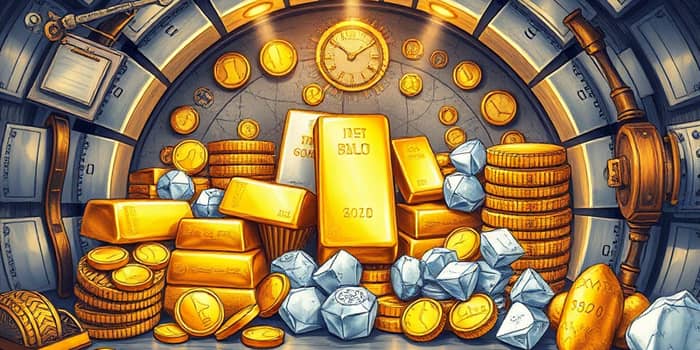The allure of gold, silver, platinum, and palladium has resonated through centuries, offering a path to preserve and grow personal wealth. As economic uncertainties rise and markets become more volatile, many seek a fortress against unpredictable swings. Precious metals stand as tangible asset that holds value, bridging ancient traditions with modern investment strategies.
Historical Significance of Precious Metals
Since the dawn of civilization, societies from Mesopotamia to medieval Europe used gold and silver as currency and symbols of power. In ancient Egypt, pharaohs adorned themselves in gold to signify divine authority. The Roman Empire minted coins from silver to pay legions and finance public works. In Asia, dynasties held vast reserves of bullion, safeguarding imperial stability.
These metals underpinned monetary systems for millennia. Even after paper money supplanted coins, nations pegged currencies to gold to maintain credibility. Industrial revolutions further cemented value: silver powered early electrical applications, while platinum became indispensable in chemical processes. Today, global central banks still hold metal reserves, a testament to their enduring trust and scarcity.
Why Invest in Precious Metals?
Investing in metals goes beyond chasing price spikes. It addresses core insecurities in modern finance: currency devaluation, systemic risk, and market contagion. Precious metals often move independently of equities and bonds, offering diversify your investment portfolio when correlations spike.
- Portfolio Diversification: Metals reduce overall volatility when equities falter.
- Inflation Hedge: Gold and silver historically resist purchasing power erosion.
- Safe Haven: Demand surges during recessions, geopolitical tensions, or financial crises.
- Tangibility: Physical holdings deliver comfort that digital assets lack.
Imagine a scenario where rapid money printing and geopolitical strife send stock indexes tumbling. Investors with metal allocations often find their holdings retain value or even appreciate, cushioning losses elsewhere. This dynamic showcases how precious metals can serve as a stabilizer in turbulent times.
Main Types of Precious Metals
Each metal brings unique characteristics—liquidity, price volatility, and industrial demand define their investment appeal.
- Gold
- Silver
- Platinum
- Palladium
Gold remains the most liquid and universally recognized, while silver offers lower entry costs and higher volatility. Platinum and palladium, though less traded, can outperform during strong industrial demand, providing opportunities for savvy investors.
How to Invest in Precious Metals
Choosing the right investment vehicle depends on objectives, risk tolerance, and time horizon. Physical metals attract those who value purchase from reputable dealers only and direct ownership, while paper instruments suit traders seeking liquidity.
- Physical Metals: Bars, coins, and rounds—requires storage, insurance, and authenticity checks.
- ETFs and ETRs: Tradable funds backed by metal—easy trading with management fees.
- Mining Stocks and Funds: Shares in companies extracting metals—offers dividends and leverage.
- Metal Certificates: Electronic claims on vault-held metal—avoids physical handling.
- Derivatives: Futures and options for advanced strategies—high leverage, higher risk.
- Numismatic Coins: Rare and collectible pieces—value tied to scarcity and condition.
Before committing capital, investors should understand the fees and tax implications of each method, as transaction costs and collectible taxes can significantly affect net returns.
Advantages and Risks
Precious metals offer clear strengths but also carry trade-offs. Their scarcity and universal acceptance make them an effective hedge against inflationary pressures, and during market collapses, they often act as a safe haven during turbulent market downturns.
However, metals produce no income—no dividends or coupon payments—so investors rely solely on price appreciation. Physical ownership entails storage, insurance, and potential liquidity constraints. Prices can swing sharply based on mining outputs, geopolitical shifts, and macroeconomic data.
Premiums paid on coins and bars, along with dealer markups, can erode returns, especially for smaller purchases. To mitigate these risks, some combine bullion with ETFs or mining stocks, blending stability with yield potential.
Building a Resilient Precious Metal Portfolio
Defining clear goals is the first step: capital preservation, growth, inflation protection, or crisis insurance. Most experts recommend allocating 5–15% of investable assets to metals, though this varies by individual circumstances.
Blending direct and indirect exposures can optimize risk and return. Physical bullion offers security, while ETFs and mining equities bring liquidity and dividends. Such a mix can offset the absence of cash flow from bullion with periodic income.
Maintain discipline: regularly review and adjust your allocation based on economic indicators like inflation reports, interest rate changes, and currency trends. Sudden spikes or drops in metal prices often correlate with global events, signaling potential rebalancing opportunities.
When holding physical assets, always purchase from reputable dealers only and verify authenticity with assay certificates. Decide between home safes—offering immediate access—and third-party vaults, which provide enhanced security and anonymity but may impose storage fees.
Tax considerations also play a critical role. In many jurisdictions, metal gains are taxed at collectible rates, which can exceed standard capital gains taxes. Developing an exit plan in advance helps minimize surprises when selling.
Lastly, ensure maintain proper storage and insurance coverage to protect against theft, loss, or damage. A well-thought-out strategy combines acquisition, custody, and liquidation plans aligned with long-term objectives.
Investing in precious metals is more than a financial maneuver—it’s a commitment to preserving heritage and securing a legacy. By understanding the history, diversifying across metals and methods, and following disciplined practices, you can fortify your wealth against the storms of tomorrow.
References
- https://www.td.com/ca/en/personal-banking/products/personal-investing/precious-metals-gold-silver-platinum/precious-metals-considerations
- https://www.investopedia.com/articles/basics/09/precious-metals-gold-silver-platinum.asp
- https://money.com/investing-in-precious-metals/
- https://www.securities.nd.gov/news/investor-advisory-precious-metals-and-coin-investments
- https://shopglobalcoin.com/blogs/blog/building-a-strong-precious-metals-investment-portfolio-tips-and-strategies
- https://www.lynalden.com/precious-metals-investing/
- https://www.investopedia.com/articles/basics/08/invest-in-gold.asp
- https://www.thrivent.com/insights/investing/what-to-know-about-investing-in-precious-metals










